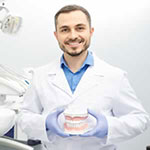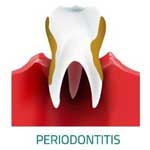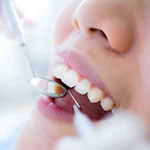
Can You Treat Periodontal Disease at Home?<
If you’ve been diagnosed with periodontitis, the more severe form of periodontal disease, you’re among the nearly half of all Americans over age 30 who live with this chronic condition. But don’t let the fact that it’s common lull you into complacency.
Periodontitis Versus Gingivitis
Periodontitis typically starts as gingivitis, or a mild inflammation of the gum tissue caused by a build-up of plaque around your teeth.
Left untreated, mild gingivitis worsens into an infection. That infection causes gums to recede and form spaces or “pockets” that collect plaque and food.
Over time, the infection becomes periodontitis and spreads below the gumline to destroy the root and bones that support the tooth.
Treatment for Periodontitis
If you suspect that you have periodontal disease, or if you haven’t seen a dentist for more than a year, visit one for an exam and professional cleaning as soon as possible.
Depending on the severity of your condition, your dentist may refer you to a Periodontist, a specialist in treating periodontal disease. Recommendations may include:
- Professional dental cleaning procedures
- Anti-microbial rinses
- Medications to fight infection
- Surgery to reduce gum pockets
- Surgery to stimulate heathy tissue and bone growth
- Education for at-home oral care
Water Flossing to Care for Periodontal Disease at Home
Treatments for periodontitis vary, but all involve taking your at-home oral care and hygiene seriously. Your dentist will instruct you on how to brush your teeth properly, and advise you to stop smoking because it makes periodontal disease worse.
Dentists also recommend Water Flossing as a gentle and effective way to continue to treat your periodontal disease at home:
- Use a water flosser at least daily. Water Flossing is easier on the gums and 29 percent more effective at removing plaque than string flossing. You can also mix anti-bacterial rinse or mouthwash with water in the reservoir.
- Choose a water flosser with variable pressure. WATERPIK countertop models offer a range of pulsing water pressures, starting as low as 10 psi for effective and gentle cleaning around sensitive teeth and gums. In addition, the Aquarius™ Professional Series offers a Hydro-Pulse Massage mode that stimulates and increases blood flow to gums, which encourages healing.
- Water Floss with the WATERPIK Pik Pocket™ tip. This specially designed tip lets you flush out plaque and food debris from deep within gum pockets without irritating tender tissues.
Learn more about the WATERPIK PIK POCKET Tip.
To floss with a WATERPIK water flosser follow these 5 steps…
- Fill the water reservoir with warm water.
- Lean over the sink and place the flosser tip into your mouth.
- Turn on the unit to start the flow of water, close your lips enough to prevent splashing.
- With your lips still mostly closed, let the water flow from your mouth into the sink.
- Move the water flosser tip along your gumline and pause briefly between your teeth.
Continue Healing Periodontal Disease at Home
If you have periodontal disease, you need to manage it daily like any other chronic condition. WATERPIK water flossers make that easy.
Countertop models offer the most features, including variable pressure settings and modes, larger water reservoirs, power control, and a variety of special tips for periodontal disease and other dental conditions.
Choose the one that best meets your at-home care needs, and choose with confidence — WATERPIK water flossers have earned the prestigious American Dental Association Seal of Acceptance.


